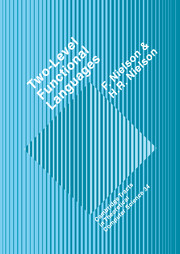
-
Select format
-
- Publisher:
- Cambridge University Press
- Publication date:
- October 2009
- July 1992
- ISBN:
- 9780511526572
- 9780521403849
- 9780521018470
- Dimensions:
- (247 x 174 mm)
- Weight & Pages:
- 0.7kg, 312 Pages
- Dimensions:
- (247 x 174 mm)
- Weight & Pages:
- 0.493kg, 312 Pages
You may already have access via personal or institutional login
Book description
The authors describe here a framework in which the type notation of functional languages is extended to include a notation for binding times (that is run-time and compile-time) that distinguishes between them. Consequently the ability to specify code and verify program correctness can be improved. Two developments are needed, the first of which introduces the binding time distinction into the lambda calculus, in a manner analogous with the introduction of types into the untyped lambda calculus. Methods are also presented for introducing combinators for run-time. The second concerns the interpretation of the resulting language, which is known as the mixed lambda-calculus and combinatory logic. The notion of 'parametrized semantics' is used to describe code generation and abstract interpretation. The code generation is for a simple abstract machine designed for the purpose; it is close to the categorical abstract machine. The abstract interpretation focuses on a strictness analysis that generalises Wadler's analysis for lists.
Contents
Metrics
Altmetric attention score
Full text views
Full text views help Loading metrics...
Loading metrics...
* Views captured on Cambridge Core between #date#. This data will be updated every 24 hours.
Usage data cannot currently be displayed.
Accessibility standard: Unknown
Why this information is here
This section outlines the accessibility features of this content - including support for screen readers, full keyboard navigation and high-contrast display options. This may not be relevant for you.
Accessibility Information
Accessibility compliance for the PDF of this book is currently unknown and may be updated in the future.


